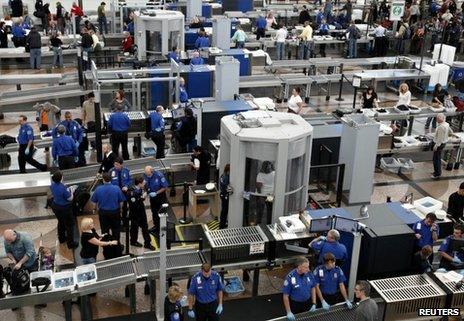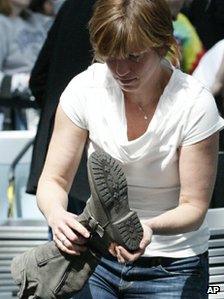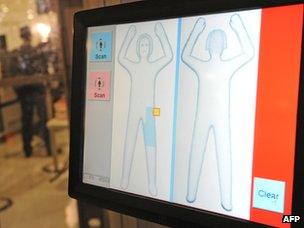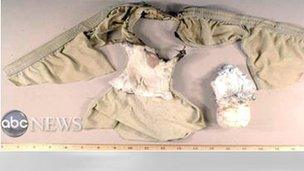Human bombs: Are they a realistic threat?
- Published

The underwear bomb that surfaced in Yemen this month has reignited concern that al-Qaeda's bomb-makers are finding innovative ways to hide explosive devices - even placing them within the body. How worried should we be?
A body cavity device would be just the latest chapter in the deadly cat and mouse game played between al-Qaeda and Western security officials when it comes to aviation. The terror group has consistently sought out new means of evading airport security regimes.
After the use of box cutters and hijackings on 9/11, cockpit security was enhanced.
But only a few months later, a shoe bomb nearly brought down a plane - and the introduction of security checks on footwear. By 2006 al-Qaeda had moved on to developing bombs made out of fluids, in turn leading to restrictions on liquids in hand luggage. In 2009, an underwear bomb worn by a young Nigerian nearly brought down a flight to Detroit.

A shoe bomb plot led to airport footwear checks...
A few months before that incident, a young man had offered to surrender to Prince Mohammed bin Nayef, who runs Saudi Arabia's counter-terror operations. He insisted that he wanted to do so in person. When he met the prince at his villa in Jeddah, a phone call triggered a hidden bomb.
The bomber's body was flung in all directions and part of his arm was embedded into the ceiling but remarkably, the prince was not seriously hurt. The exact nature of the device has been the source of some dispute, with some claiming it was internally placed in the rectum, others that it was an underwear bomb.
The bomber, Abdullah al-Asiri, was carrying a device believed to have been built by his brother Ibraham al-Asiri, al-Qaeda's master bomb-maker in Yemen and arguably the most dangerous and most wanted al-Qaeda associate individual globally. He is credited with a number of innovative devices ranging from the underwear bombs to the devices hidden in printer cartridges bound for the US on cargo flights (which were only discovered thanks to an intelligence tip-off).
On Monday, the group showed how deadly its devices could be when a suicide bomber killed close to 100 soldiers in Sanaa.
A detailed 2011 report by Dr Robert J Bunker, of Claremont Graduate University, argues that the trend is moving bombs closer to the body - and the logical extreme is to place bombs inside the body.
Drug smugglers frequently hide packages in body cavities such as the lower digestive tract. And in World War II, the forerunner of the CIA hid escape kits within the rectum.
"If you go back in the military history literature, the placing of explosive booby traps such as fragmentation grenades under, and even inside of, the corpses of soldiers is a very common phenomenon," Bunker says. "This was especially evident in the Pacific Theatre in World War II and in the Vietnam War."

... and a plot involving drinks bottles led to a crackdown on liquids in hand luggage
One step beyond inserting a bomb in a body cavity is to undergo a medical procedure and open someone up, place the bomb inside their body and sew them up again. This has been attempted with animals. In 2010, al-Qaeda in Iraq reportedly surgically implanted bombs into dogs in order to send the canines on planes to the US on which they would explode. In this case, the animals died before the plan could be carried out.
Surgically inserting a bomb requires considerably medical skill, and al-Qaeda bomb-maker al-Asiri has reportedly been working with doctors to see if it can be done.
"The surgeon would open the abdominal cavity and literally implant the explosive device in amongst the internal organs," Dr Mark Melrose told ABC News, external. Other reports suggest devices could be placed in the breasts of female bombers much like an implant.
However, one Gulf-based security expert says he has seen no evidence to support reports of doctors working on surgically-implanted bombs.

What if the flight is delayed?
So could such bombs be developed? The underwear bombs seized in 2009 and 2012 have no metal components and so can pass through metal detectors. After the underwear plot of 2009, there was pressure to introduce more body scanners at airports. Despite the objections of travellers who felt the images invaded their privacy, these machines have been introduced at some airports in the US and Europe. But in some parts of the world - notably the Middle East - they are barely used at all.
While scanners may be able to pick up the type of concealed underwear bomb used in 2009, they may not pick up a device within the body. How else might such a bomb be detected?
A medical X-ray machine might do it (just as it can pick up drugs hidden within the body), but concerns would be raised about exposing travellers to this level of radiation.
Testing for explosive residue is another option, but careful bomb-makers leave precious little contamination.

The scanners have provoked protests from those who find the images intrusive
More emphasis may need to be placed in future on looking for suspicious behaviour at airports and forms of "soft" interrogation by security personnel - a tactic Israel has used.
But while al-Qaeda may want to use this type of bomb, one security source tells me it may not be so easy to carry out in practice. Would a bomber with a device sewn into their body be fit to travel, and without exhibiting signs of recent surgery?
Bomb-makers would also face the problem, experts say, of working out how much of the explosion the body itself would absorb. This may have been what saved Prince Nayef - it's possible that most of the blast was absorbed by his attacker's body, or the impact travelled into the floor. This may make the body bomb less useful as a tool for assassination. But in a plane, all that may be needed is an explosion just strong enough to punch a hole in a pressurised cabin.
But the main challenge in such bombs, experts say, is detonation. If a timer is sewn into the body with the device, then what could the bomber do if the flight is delayed?

The 2009 underwear bomb had a syringe detonator
The 2009 underwear bomb was thought to have used a chemical detonator delivered by syringe, but this failed to work and instead just burned the bomber.
The 2012 version is thought to have this element upgraded, but the details have not been made public. And if a bomb is placed internally, rather than worn, it would be even harder to ensure a syringe hits the right point.
Detonation through a phone call (as used in Jeddah against Prince Nayef) is an option, but only if you can guarantee phone coverage in flight, which is not always the case.
The body bomb may so far be an unproven concept but al-Qaeda - and particularly its affiliate in Yemen - has shown itself to be unrelenting in its desire to strike the US, and especially planes.
It has also shown itself remorselessly innovative in the search for new ways to achieve its deadly goals.
- Published10 May 2012